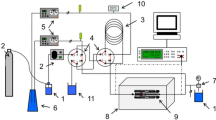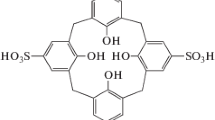Abstract
The limiting molar conductances Λ° of deuterium chloride DCl in D2O were determined as a function of pressure and temperature in order to examine the proton-jump mechanism in detail. The excess deuteron conductances λ°E(D +), as estimated by the equation [λ°E(D +) = Λ°(DCl/D 2 O) − Λ°(KCl/D 2 O)], increases with an increase in the pressure and temperature as well as the excess proton conductance [λ°E(H +) = Λ°(HCl/H 2 O) − Λ°(KCl/H 2 O)]. The isotope effect on the excess conductances, however, depends on the pressure and temperature contrary to the model proposed by Conway et al.: λ°E(H +)/λ°E(D +) decreases with increasing pressure and temperature. The magnitude of the decrease with pressure becomes more prominent at lower temperature. These results are discussed in terms of the pre-rotation of adjacent water molecules, the bending of hydrogen bonds with pressure, and the difference in strength of hydrogen bonds between D2O and H2O.
Similar content being viewed by others
References
B. E. Conway, inModern Aspects of Electrochemistry, Vol. 3, J. O'M. Bockris and B. E. Conway, eds., (Butterworths, London, 1964), Chap. 2.
A. Gierer,Z. Naturforsch. 5a, 581 (1950).
A. Gierer and K. Wirtz,J. Phys. Chem. 56, 914 (1952).
A. Eucken,Z. Elektrochem. Angew. Phys. Chem. 52, 225 (1948);Nachr. Ges Wiss. Gsttingen Math-Phys. Kl. 1 (1949).
B. E. Conway, J. O'M. Bockris, and H. Linton,J. Chem. Phys. 24, 834 (1956).
M. Nakahara and J. Osugi,Rev. Phys. Chem. Jpn. 47, 1 (1977).
M. Ueno, M. Nakahara, and J. Osugi,J. Solution Chem. 8, 881 (1979).
M. Nakahara, N. Takisawa, and J. Osugi,J. Phys. Chem. 85, 112 (1981).
G. S. Kell,J. Chem. Eng. Data 12, 66 (1967).
C. T. Chen and F. J. Millero,J. Chem. Phys. 75, 3553 (1981).
G. S. Kell,J. Chem. Eng. Data 20, 97 (1975).
C. T. Chen, R. A. Fine, and F. J. Millero,J. Chem. Phys. 66, 2142 (1977).
The values of the viscosity at 1 atm are taken from Ref. 14 for D2O and Ref. 16 for H2O: they are multiplied by the relative viscosities at high pressure and various temperatures, which are obtained by fitting the relative viscosities at various temperatures at each pressure in Ref. 15 for D2O and Ref. 17 for H2O to a fifth-order polynominal in temperature.
F. J. Millero, R. Dexter, and E. Hoff,J. Chem. Eng. Data 16, 85 (1971).
A. Harlow, Ph.D. Thesis, London University (1969).
L. Korson, W. Dorst-Hansen, and F. J. Millero,J. Phys. Chem. 73, 34 (1969).
J. B. Cappi, Ph.D. Thesis, London University (1964); K. E. Bett and J. B. Cappi,Nature 207, 620 (1965).
The values of dielectric constant are obtained by assuming that the logalithmic form of the quantity reported in Ref. 19 up to 3 kbar in the temperature range 10–40°C is expressed by a linear function of temperature at high pressure as well as 1 atm as shown in Ref. 20.
K. R. Srinivasan and R. L. Kay,J. Chem. Phys. 60, 3645 (1974).
R. L. Kay, G. A. Vidulich, and K. S. Privadi,J. Phys. Chem. 73, 445 (1969).
Bunseki Kagaku Binran, The Chemical Society of Japan, ed., (Maruzen, Tokyo, 1971), p. 235.
L. E. Strong,J. Chem. Eng. Data 25, 104 (1980).
B. B. Owen and H. Zeldes,J. Chem. Phys. 18, 1083 (1950).
G. C. Benson and A. R. Gordon,J. Chem. Phys. 13, 473 (1945).
J. F. Lind, J. J. Zwolenik, and R. M. Fuoss,J. Am. Chem. Soc. 81, 1557 (1959).
The cell constant K of a glass cell at 65°C was obtained by taking into consideration the expansibility of glass, while the cell constant of a Teflon cell at 65°C was estimated by using the relation ofK (Teflon)/R (Teflon)=K (glass)/R (glass), whereR is the resistance of a 0.01M KCl solution.
M. Ueno, N. Tsuchihashi, and K. Shimizu,Bull. Chem. Soc. Jpn. 58, 2929 (1985).
R. L. Kay,J. Am. Chem. Soc. 82, 2099 (1960).
R. M. Fuoss and F. Accascina,Electrolytic Conductance (Interscience, New York, 1959), Chap. 15.
P. C. CarmenJ. Phys. Chem. 74, 1653 (1970).
M. Ueno, A. Yoneda, N. Tsuchihashi, and K. Shimizu,J. Chem. Phys. 86, 4678 (1979).
K. Shimizu and N. Tsuchihashi,Rev. Phys. Chem. Jpn. 49, 18 (1979).
M. Ueno, K. Ito, N. Tsuchihashi, and K. Shimizu,Bull. Chem. Soc. Jpn. 59, 1175 (1986).
M. Nakahara, M. Zenke, M. Ueno, and K. Shimizu,J. Chem. Phys. 83, 280 (1985).
M. Ueno, N. Tsuchihashi, and K. Shimizu,J. Chem. Phys. 92, 2548 (1990).
S. D. Hamann and W. Strauss,Trans. Faraday Soc. 51, 1684 (1955).
S. D. Hamann,Physicochemical Effects of Pressure (Butterworth, London, 1957), Chap. 7.
A. J. Ellis,J. Chem. Soc. 3689 (1959).
R. A. Horne, B. R. Myers, and G. R. Frysinger,J. Chem. Phys. 39, 2666 (1963).
E. U. Franck, D. Hartmann, and F. Hensel,Discuss. Faraday Soc. 39, 200 (1965).
M. Nakahara and J. Osugi,Rev. Phys. Chem. Jpn. 47, 1 (1977).
G. A. Gaballa and G. A. Neilson,Mol. Phys. 50, 97 (1983).
A. H. Narten, M. D. Danford, and H. A. Levy,Discuss. Faraday Soc. 43, 97 (1967).
J. Morgan and B. E. Warren,J. Chem. Phys. 6, 666 (1938).
F. H. Stillinger and A. Rahman,J. Chem. Phys. 61, 4973 (1974).
R. W. Impey, M. L. Klein, and I. R. McDonald,J. Chem. Phys. 74, 647, (1981).
E. Whalley,J. Chem. Phys. 63, 5205 (1975).
E. H. Grant and R. Shack,Trans. Faraday Soc. 65, 1519 (1969).
R. A. Kuharski and J. Rossky,J. Chem. Phys.,82, 5164 (1985).
D. Eisenberg and W. Kauzmann,The Structure and Properties of Water (Oxford University, London, 1969).
Author information
Authors and Affiliations
Rights and permissions
About this article
Cite this article
Tada, Y., Ueno, M., Tsuchihashi, N. et al. Pressure and temperature effects on the excess deuteron and proton conductance. J Solution Chem 21, 971–985 (1992). https://doi.org/10.1007/BF00650873
Received:
Revised:
Issue Date:
DOI: https://doi.org/10.1007/BF00650873




